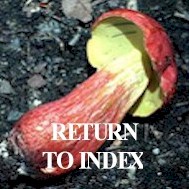
CONVENTIONAL SHORTHAND SYMBOLS IN BOTANICAL NOMENCLATURE
1. "apud" Not common. When a name, extensive notes, illustrations or other important data are contributed by a worker, but the name is formally published by another (whether contemporary or not), the contributing worker's name can be cited, separated from the publishing author by apud.
Ex: Klotzsch's herbarium includes a specimen with notes of an unnamed cantharelloid fungus. The fungus was published by Berkeley as Cantharellus canadensis Klotzsch, but this is incorrect. If anything, the name could be cited as C. canadensis Klotzsch apud Berkeley.
2. "in" Common. When an author described a taxon in the publication of another author, or under combined authorship, the describing author should be cited, separated from the publishing author(s) by in.
Ex: Smith published Cantharellus wilsonii in a publication authored by Smith and Morse. The name of the taxon should be cited as C. wilsonii Smith in Smith and Morse.
Ex: P. Hennings proposed Lachnocladium lauterbachii in Engler and Prantl's Naturlichen Pflanzenfamilien, and the name should be cited as L. lauterbachii Hennings in Engler & Prantl.
3. "ex"
1). Validly publishing author ascribes the name to another author. see also apud.
2). First introduction is pre-starting date (regardless of taxonomic group). See also "per;" see also square brackets.
Ex: (obsolete): Schaeffer (1779) proposes the name Agaricus citrinus. The name is later sanctioned by Fries (1821; starting point work). The name can be cited as A. citrinus Schaeffer ex Fries. 3). First valid publication was as a synonym.
4. "per" Not common. For use together with "ex" in the following situation: Only in groups with later starting or sanctioning date, the name of an author who described a taxon between 1753 and the later starting or sanctioning date may be cited and separated from the validating or sanctioning author's name by per.
Ex: In item 3.2) above, the name may be cited as Agaricus citrinus Schaeffer per Fries. This could not apply to item 3.1) above.
5. quotation marks.
1). To point out a misspelled name in a citation, that name may be placed between quotation marks, and should be placed AFTER the rest of the citation itself.
Ex: See listings in ICBN Appendix III. 2). To refer to the date on the title page of a publication which disagrees with the real date of publication, the ostensible date of publication may be placed in quotation marks, and the real date in parentheses.
Ex: The report of the state botanist of New York for 1908 was published in 1909, and may be cited as follows: Rept. N.Y. State Mus."1908" (1909).
6. "!" A general sign indicating personal examination and approval.
Ex: used after citation of a type specimen, the "!" indicates that the author has seen the type and approves of it.
7. "=" An indication of a taxonomic (or facultative) synonym. Two names thought to represent contaxic entities, based on two different types. A taxonomic act, not nomenclatural.
Ex: Ramaria rubella Schaeffer per Krombholz = Ramaria acris (Peck) Corner
8. "º "
1). When two or more names are based on a single type, they are to be considered as nomenclatural (or obligate) synonyms. They are "typonyms" and may be cited with "º ". Such synonyms are usually indented.
Ex: Gomphus Persoon per S.F. Gray º Gomphora Fries
º Merulius sect. Gomphus Persoon]
2) When a new name is an avowed substitute for another (nomen novum), the two names are based on the same type.
Ex: If Lachnocladium strictum Coker is transferred to Ramaria, it becames a later homonym of Ramaria stricta (Pers. per Fr.) Corner. A new name is required, but it is only a nomen novum (not species novum). The new name is Ramaria henningsii Petersen, and nomenclatural synonymy is to be cited as follows: Ramaria heniingsii Petersen
º Lachnocladium strictum Coker
9. "et" and "&" Used to link two (and only two) authors of a name. When three or more, use the first author plus et alia (abbreviated et al.).
10. "[ ]" Square brackets.
1). An alternative method to "ex" (that is, citation of pre-starting date author).
2). Statement of information not nomenclaturally essential, but deemed informative by the monographer (i.e. pre-starting date names, nomina herbariora, etc.)
FOR ADDITIONAL SHORTHAND SYMBOLS SEE RECOMENDATIONS FOR ARTICLE 58.